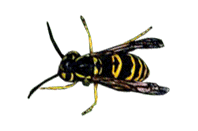Bees
Rid your home of unwanted pests with guaranteed service from Eagle Pest Control. Eagle’s pest control maintenance service is designed to keep you home pest-free by creating a protective barrier around the exterior of your home. We use extremely effective, long-lasting products that are safe to use in homes, schools, day cares, and food service establishments.
Our full-service maintenance plans are inclusive of all general household pests. You will have a pest-free environment, both inside and outside of your home or business – Guaranteed.
For additional resources, surf to:
Your Trusted Choice for the Best in Pest Control
One Source for Many Resources
Eagle Lawn Service is a division of Eagle Lawn Service & Pest Control. We specialize in caring for your lawn, as well as riding your house of bugs, termites or other unwanted creatures. It’s your home. We provide a service that works so you don’t have to.
ADDITIONAL INFORMATION ON THESE COMMON PESTS:
Carpenter Bee
The carpenter bee got its name from mining wood, similar to carpenter ants. There are several varieties of these bees. The majority of carpenter bees are large, around ¾", and primarily black with a green or purple sheen to them. Some unique features include a patch of yellow, orange, or white hair on the thorax, and a shiny abdomen. Other types of carpenter bees can be more of a light brown color. Male carpenter bees, who lack a stinger, can be distinguished by white markings on their head. Carpenter bees can be intimidating when they hover around people, but the males can't sting and females are docile and rarely sting. Boring into wood to lay eggs is typically the biggest nuisance this bee causes. A carpenter bee hole is around ½" diameter, and so round it looks like it was made with a drill. These holes can be hidden on the undersides of boards, so sometimes the sawdust left behind will be a tip off as to their presence. At a boring rate of 1/16" per day, carpenter bees don't usually cause as much damage as other wood destroying pests. Though, if left untreated for years it is possible for them to cause enough damage to warrant repairs. The best way to prevent carpenter bees from boring into your home is to keep it painted. If they have already started boring, the holes should be treated individually. After the holes are treated, plug them with a dowel or steel wool/and or caulking. This will discourage new bees from using these holes in the future.
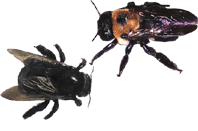
Honey Bee
Honey bees are common, and beneficial insects most of the time. They are named for their habit of making honey, which they use as food during parts of the year. Excesses of this honey can be harvested for humans to eat. Honey bees also pollinate the flowers of fruits and vegetables, and are a very important species to farmers. Around ½" long, the honey bee is not aggressive unless provoked. Be careful around honey bee nests, because they will attack if they feel the nest is in danger. If honey bees decide to make a colony inside your home, they can become a nuisance and may need to be removed. Sometimes tearing open walls is necessary to remove the honeycomb and dead insects.
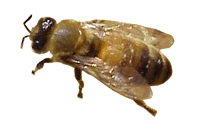
Africanized Honey (Killer) Bee
The Africanized honey bee is an example of the ill effects of trying to improve on nature. In the 50's an African queen was brought to Brazil, to try and make a superior honey bee. Colonies of these African bees mated with honey bees, creating the Africanized honey bee. These bees have been making their way north ever since. This bee has been referred to as a "killer bee" because of its aggressiveness. They are no more poisonous than honey bees, in fact they are basically honey bees with bad tempers. They will gang up on a victim, and chase them for much longer than a regular honey bee. The Africanized honey bee looks identical to a honey bee, but may be slightly smaller in size. These killer bees aren't domesticated, and nest in a wider range of places than honey bees. There have been attacks in southern California, but they aren't really a problem in this area. It is important to keep them in mind however, because they are spreading.
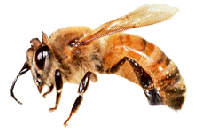
Cicada Killer Wasp
The Africanized honey bee is an example of the ill effects of trying to improve on nature. In the 50's an African queen was brought to Brazil, to try and make a superior honey bee. Colonies of these African bees mated with honey bees, creating the Africanized honey bee. These bees have been making their way north ever since. This bee has been referred to as a "killer bee" because of its aggressiveness. They are no more poisonous than honey bees, in fact they are basically honey bees with bad tempers. They will gang up on a victim, and chase them for much longer than a regular honey bee. The Africanized honey bee looks identical to a honey bee, but may be slightly smaller in size. These killer bees aren't domesticated, and nest in a wider range of places than honey bees. There have been attacks in southern California, but they aren't really a problem in this area. It is important to keep them in mind however, because they are spreading.
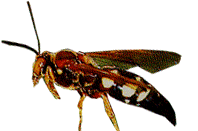
Baldfaced Hornet
The western cicada killer is named for its practice of stinging cicadas (an insect in the aphid family) and bringing them back to their eggs for food. When the larvae hatch out of the eggs, they feed on the cicada as they develop. Western cicada killers are sometimes over an inch long, making them the largest wasp in California. They are solitary insects, but can be a nuisance if there are enough of them, and will sting if provoked. Overall, their place in the food chain makes them valuable, so they shouldn't be killed unless it is necessary.
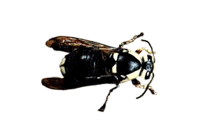
Mud Dauber Wasp
The mud dauber wasp is named for the way the females construct nests from bits of mud. Their nests are made up of tube shaped chambers, usually attached under eves. These wasps are around ¾" long, mostly black, and depending on the variety have some yellow markings. They also have a very narrow, almost string-like waist. Solitary and non aggressive, these wasps rarely sting or defend their nest like other, more social insects. Instead, mud daubers use their stingers to hunt other pests such as spiders. Their old nests can be a nuisance and if not active, can be scraped down. Just be aware that mud dauber wasps can be persistent at rebuilding their nests.
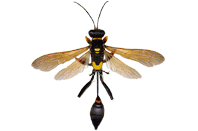
Mason/Potter Wasp
The mason and potter wasps are named for jug-looking nests they build from mud or clay. They are around ½" long, and similar in appearance to the mud dauber wasp. Although they have the capability to sting, mason and potter wasps are solitary and non aggressive. Capturing larvae of various other pests for food, these wasps are beneficial to the food chain. Since they don't defend their nests, they shouldn't need to be controlled unless they in an area where they are a nuisance.
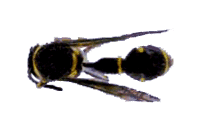
Paper Wasp
The paper wasp is named for its cellular nest constructed of papery material. Paper wasps are around 5/8" long, and dark brown and yellow colored - sometimes with areas of red. These wasps are beneficial in controlling other pest populations, but can be a nuisance. Existing in small colonies, they can become aggressive if they feel their nest is in danger. It is common to see their umbrella shaped nests hanging from eaves outside the house, though they build them in various other places. These nests shouldn't be knocked down without first killing the adult wasps. Aside from the risk of being stung, the nest will be rebuilt.
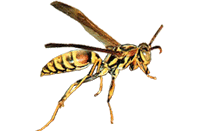
Wood Wasp (Horntail)
The wood wasp, or horntail, is named for making its home in trees or for the shape of its abdomen. They are called a wasp because of their resemblance to a wasp, but actually don't sting. Wood wasps are around an inch long, and mostly black. They bore into trees in nature to lay their eggs, but won't bother new construction. The problem arises when trees containing partially developed wood wasps are harvested, and turned into lumber. Between a year and three years after construction with the infested lumber, wood wasps will emerge, and chew a ¼" hole through anything covering it. This includes drywall, linoleum, and hardwood. Buying kiln-dried lumber insures the absence of wood wasps and other wood pests, but is costly. There isn't much that can be done to control the wasps, aside from letting them emerge and killing the adults. In extreme situations, fumigation or heating can be done similar to wood boring beetles.
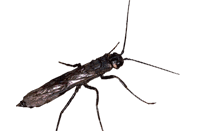
Yellowjacket
The yellowjacket is named for its black and yellow coloring. These insects are around ½" long, and a big nuisance. They are social with large colonies, and fly around foraging for food. Although they are a predator of other pests, yellowjackets also will eat food scraps that are left out, making outdoor eating difficult when they are present. Their nests are usually hidden underground, so keep an eye out for the entrance. Yellowjackets aggressively defend their nest, and running into it by accident will probably mean getting stung. Baited yellowjacket traps are effective at killing significant numbers of the workers. Though ideally, the nest would be located and treated to obtain control.
